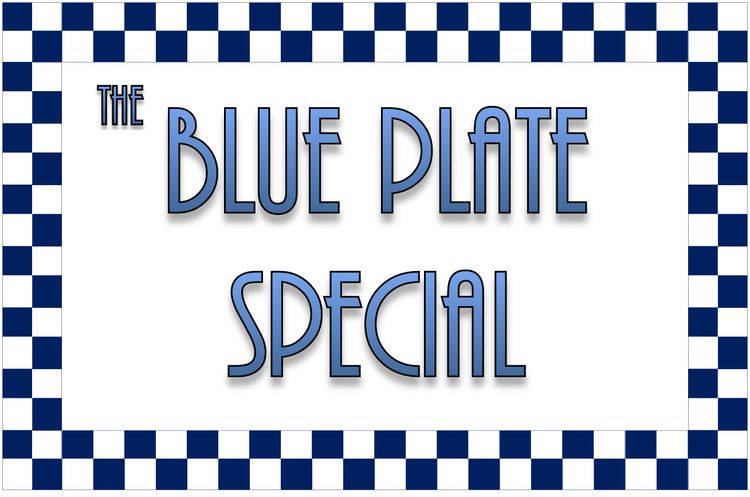Blue-plate special or blue plate special is a term used in the United States by restaurants, especially diners and cafes. It refers to a low-priced meal that usually changes daily.
Contents
The term was very common from the 1920s through the 1950s. As of 2007, there are still a few restaurants and diners that offer blue-plate specials under that name, sometimes on blue plates, but it is a vanishing tradition. The phrase itself, however, is still a common American colloquialism.

A web collection of 1930s prose gives this definition: "A Blue Plate Special is a low-priced daily diner special: a main course with all the fixins, a daily combo, a square for two bits."

History

The origin and explanation of the phrase are unclear. Kevin Reed says that "during the Depression, a manufacturer started making plates with separate sections for each part of a meal—like a frozen dinner tray—it seems that for whatever reason they were only available in the color blue." Michael Quinion cites a dictionary entry indicating that the blue plates were, more specifically, inexpensive divided plates that were decorated with a "blue willow" or similar blue pattern, such as those popularized by Spode and Wedgwood. One of his correspondents says that the first known use of the term is on an October 22, 1892 Fred Harvey Company restaurant menu and implies that blue-plate specials were regular features at Harvey Houses.

The term became common starting in the late 1920s. A May 27, 1926 advertisement in The New York Times for "The Famous Old Sea Grill Lobster and Chop House" at 141 West 45th Street promised "A La Carte All Hours", "Moderate Prices", and "Blue Plate Specials". A December 2, 1928 article, lamenting the rise in prices that had made it difficult to "dine on a dime," praised an Ann Street establishment where one could still get "a steak-and-lots-of-onion sandwich for a dime" and a "big blue-plate special, with meat course and three vegetables, is purchasable for a quarter, just as it has been for the last ten years." The first book publication of Damon Runyon's story, "Little Miss Marker," was in a 1934 collection entitled Damon Runyon's Blue Plate Special. A Hollywood columnist wrote in 1940, "Every time Spencer Tracy enters the Metro commissary, executives and minor geniuses look up from their blue plate specials to look at the actor and marvel." In the 1953 The Honeymooners episode "Suspense," Ralph, suspecting that Alice plans to murder him with a carving knife, says to Norton, "Did you hear that, pal? She wants to borrow a carving knife. I never thought I'd end up a blue-plate special."
"No substitutions" was a common policy on blue-plate specials. One 1947 Candid Microphone episode features Allen Funt ordering a blue-plate special and trying to talk the waiter into making various changes, such as replacing the vegetable soup with consommé, while the polite but increasingly annoyed waiter tries in vain to explain to Funt that "no substitutions" means what it says. Our Man in Havana (1958) by Graham Greene has the following exchange regarding an "American blue-plate lunch":
Contemporary usage
In contemporary usage, a "blue-plate special" can be any inexpensive full meal, any daily selection, or merely a whimsical phrasing. Travel columnist Wayne Curtis says that a Portland, Maine eatery offers "budget blue-plate specials along with more refined fare."
In events
Boston Children's Museum presents a participatory-theater show, sponsored by health insurer Blue Cross, which teaches good nutrition; the show is called Blue Plate Special.
Workman's Blue Plate Special is "a monthly eCookbook Club, bringing you specially discounted and free eBooks from an award-winning collection of cookbooks".
In film and television
The Turner South cable channel calls a daily movie selection, scheduled at lunchtime, its "blue-plate special".
In print
Richard Bernstein titled his New York Times review of Andrew Hurley's book Diners, Bowling Alleys, and Trailer Parks (2001), "The Red, White and Blue Plate Special".
Mystery writer Abigail Padgett's second novel about amateur sleuth Blue McCarron is titled The Last Blue Plate Special (2001); no meals here, the blue plates are part of the decor at a clinic where patients are dying mysteriously.
Road food experts Jane and Michael Stern titled their guidebook Blue Plate Specials and Blue Ribbon Chefs: The Heart And Soul of America's Great Roadside Restaurants (2001).
